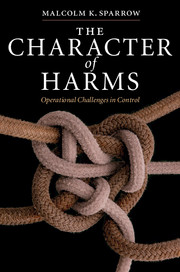Book contents
- Frontmatter
- Contents
- List of figures
- Acknowledgments
- Introduction
- Part I The nature of the control task
- 1 Which way up, and does it matter?
- 2 A different type of work
- 3 Defining problems: setting the scale
- 4 Defining problems: picking the dimensions
- 5 Patterns of thought and action
- 6 Puzzles of measurement
- 7 Structures, protocols, and interactions
- Part II Special categories of harms
- Conclusion
- Index
1 - Which way up, and does it matter?
from Part I - The nature of the control task
Published online by Cambridge University Press: 06 July 2010
- Frontmatter
- Contents
- List of figures
- Acknowledgments
- Introduction
- Part I The nature of the control task
- 1 Which way up, and does it matter?
- 2 A different type of work
- 3 Defining problems: setting the scale
- 4 Defining problems: picking the dimensions
- 5 Patterns of thought and action
- 6 Puzzles of measurement
- 7 Structures, protocols, and interactions
- Part II Special categories of harms
- Conclusion
- Index
Summary
From a purely mathematical or economic perspective, promoting good things and reducing the countervailing bad things look to be one and the same; conceptually identical, and with a difference only in vantage point. One might conclude, therefore, that it makes no practical difference which way up one looks at such things. From an operational point of view, however, it makes a considerable difference. Scrutinizing the harms themselves, and discovering their dynamics and dependencies, leads to the possibility of sabotage. Cleverly conceived acts of sabotage, exploiting identified vulnerabilities of the object under attack, can be not only effective, but extremely resource-efficient too.
Across the spectrum of harm-reduction tasks, we observe practitioners thinking and then acting like saboteurs. They may not use the language of sabotage, but they nevertheless engage in an analytical search for vulnerabilities of the harm itself: some critical commodity, a pivotal node in a network, an irreplaceable ingredient, or inescapable dependency of some kind. Finding such a vulnerability leads them quite naturally to an action plan which exploits that vulnerability with surgical precision.
One famous example involved the demise of the Alberto Larrain Maestre heroin-smuggling ring, otherwise known as the French Connection. A law enforcement analyst determined that the entire operation relied heavily on a small set of specialists, called courier-recruiters, operating in French airports.
- Type
- Chapter
- Information
- The Character of HarmsOperational Challenges in Control, pp. 27 - 46Publisher: Cambridge University PressPrint publication year: 2008



